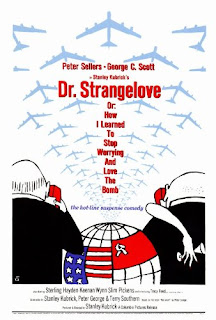"Gentlemen, you can’t fight in here! This is the war room!"
Time once again to talk about the master, the magnificent,
the one and only Stanley Kubrick. I’ve looked over his seminal work of 2001, which
dealt with themes of evolution and rebirth—here, we look at something that looked
at the exact opposite, namely apocalyptic atomic destruction and mankind’s
inevitable and very stupid extinction. It’s the ultimate in black comedy—Doctor
Strangelove. Or, if you want the full title, How I Learned to Stop Worrying and
Love the Bomb (I sure didn’t).
To give the context, the film was made in the wake of the
Cuban Missile Crisis, an event that saw America wake up to the ever-reassuring
sight of President Kennedy looking very tired and haggard, and having to
explain in euphemistic terms that they might all die that night (boy, between
this and Godzilla, we have been talking about nuclear annihilation lately
haven’t we?). Kubrick, something of a misanthropic mofo, decided to make a
comedy film out of all this, loosely adapting the novel ‘Red Alert’. To this,
he bought on Peter Sellers, one of the great comic actors of the period, and
certainly got his mileage with him, giving him no less than three roles, which
ranged from a stuffy RAF officer to a manic ex-Nazi scientist with…severe issues.
The rest of the cast is also spot on—Sterling Hayden gives a
completely straight face playing a complete lunatic in the form of General
Ripper, an Air Force commander that goes rogue and launches an all-out nuclear
bomber assault on the basis of conspiracy theories and national stereotypes. Of
course, in real life, we can be thankful that sort of thing never happens.
My personal favorite is George C Scott as General Turgidson,
who Kubrick slyly directed into giving such a manic performance that contrasts
so well with one of Seller’s three performances, as the straight-laced if
slightly awkward US President. Imagine something akin to Patton if he was
partially transplanted into the body of a sugar-high twelve year old and you
might get the idea—it’s hilarious and all kinds of entertaining. Likewise, his
character highlights the sheer insanity of cheering on the oncoming bombing on
the basis that his nation will suffer less ‘megadeaths’ this way. Of course, in
real life, we can be thankful this sort of crazed short-sightenedness never
happens.
The movie cuts between three interconnected threads: Sellers’
RAF officer desperately looks for recall codes on Ripper’s besieged base; the iconic
war room set where the President, Soviet ambassador, and the eponymous German wheelchair-bound
lunatic try to defuse things literally and metaphorically; and finally, the crew
of a B-52 bomber on their date with destiny. Slim Pickens delivers yet another
amazingly memorable performance as the cowboy-hat wearing bomber commander
hellbent on unloading his payload—all puns intended, given the imagery we see
at the end. You’ll even see a young James Earl Jones as one of the bombardiers.
Kubrick plays on the delicious dark irony of setting things up so the audience
cheers for this crew even as they unwittingly saunter off to Armageddon; it’s
like a traditional war movie in presentation, except you know they’re just
going to screw everything up even more.
And then there’s Strangelove himself. Despite the title he’s
not occupying that much screentime, nor is he even really one of the main
characters; but dear god Sellers chews the set so much you’d think it was made
from bacon. Of course, in real life, the US government happily recruited Nazi
scientists aboard in the name of defeating communism, with Kubrick gleefully
taking this to its logical conclusion. Fortunately, in the decades since, we can
be thankful such insane loonies NEVER have cropped up in US
administrations.
Dr. Strangelove is that kind of film I can’t really seen
being made in the mainstream these days; utterly dry and black in humor,
painting both sides of a global divide in a very unflattering light, and ending
on a less than optimistic end. Nevertheless, it’s still grimly hilarious, the performances
are excellent, and it’s insanely quotable. As for the realism? In the aforementioned
Cuban Missile Crisis, Kennedy was urged for a nuclear strike against Soviet
missile sites on intelligence that turned out was all too faulty and
underestimated the number of warheads. Kubrick, it seems, was only slightly off
when it came to the belligerence of those in charge.
Nevertheless, with all that in mind, all I can say is—it’s a
classic, one of my all-time favorite flicks, and with a recent 4k release, check it out as soon as you can.
We'll meet again, don't know where, don't know when...
We'll meet again, don't know where, don't know when...

Comments
Post a Comment